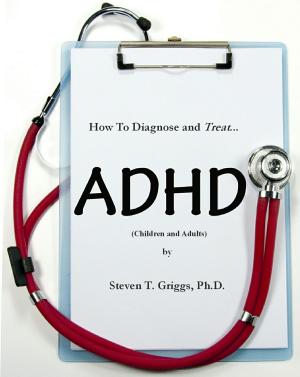How To Diagnose and Treat Mood Disorders
Nonfiction, Health & Well Being, Psychology, Clinical Psychology| Author: | Steven T. Griggs, Ph.D. | ISBN: | 9781370210244 |
| Publisher: | Steven T. Griggs, Ph.D. | Publication: | December 2, 2017 |
| Imprint: | Smashwords Edition | Language: | English |
| Author: | Steven T. Griggs, Ph.D. |
| ISBN: | 9781370210244 |
| Publisher: | Steven T. Griggs, Ph.D. |
| Publication: | December 2, 2017 |
| Imprint: | Smashwords Edition |
| Language: | English |
Here's what's in it:
Lots of vignettes--snippets of what people describe as mood fits, or mood episodes. These are little stories, primarily about depression or Bipolar disorder--the two BIG ones that are also the most common.
Statistics--how many people have mood disorders? Which ones?
Definitions: Ever wonder what's the difference between emotion, feeling, mood and affect?
What's normal? I have a scale, my way of thinking about moods based on over three decades of working with clients in an outpatient setting. There are symptom lists for all of them, and from where you are on the scale, the diagnoses. Easy.
Symptoms of anxiety. This is sometimes thought of as a mood, sometimes as a symptom accompanying moods, depending...
What moods are not, some examples of overlapping diagnostic categories and how they differ from primary mood disorders.
Then, I drill down to the specifics of each mood problem. There are eight kinds of depression and three kinds of Bipolar, plus some sub-bipolar types.
Ever thought of what causes mood problems? There are physical and psychological causes. I cover them in common language.
Then, what about treatment? I go through exactly what I do in the office. I look at genetics, long-term history, near-term history, substance use (including alcohol), diet, sleep, medical conditions, medication side-effects, social supports. I tell you how to think about each.
Therapy? The best models, like CBT and DBT.
Unique to this ebook is the next section on Related Findings. There are 40 studies that give you more ways to think about and to handle moods--many of them are surprising. All of them are helpful.
The next section is on Herbs. There are many that do the same thing as medication, only with less side effects. They're also cheaper, more available and you don't have to go through your doctor, insurance company or pharmacy. Herbs work on moods and anxiety.
Next is a section on supplements. Same idea--lots of things to try that you can regulate. Science has validated many of these, just like herbs.
Of course, there's also a section on medication. Herbs and supplements don't always work, so if and when that becomes true, here's a list of the meds that are commonly used, for which moods, why and how they work and their potential side effects.
But wait...there's more. Recent research has uncovered many alternative treatments, especially for depression. I present seven.
For those researchers among you, there's also a lengthy Bibliography so you can look up my original sources.
Lastly, there's a section for Quotes, which I really like. This provides a more human and poetic element, a personal touch when thinking about moods.
Most of the pop-psychology books are too long. I’ve boiled down the concepts in these books into clear, manageable steps. I’ve made this as easy to understand as is humanly possible, combining what I’ve read with what I’ve learned from clients.
Like my other ebooks, this one has no fat. Think of it as a "Cliffs Notes" publication. It's "sort of" a quick read (about an hour or two). I have to explain a few new terms, because there are new ideas and the terms you probably already know are put together in new ways. The theory I espouse is different from standard "behavior change" books. It works better and is very simple to understand. That's the point of an ebook. My research has not turned up another ebook that does what mine does.
Ebooks are replacing standard books because they are quicker and easier to obtain. There is a need for immediate information, reasonably priced. I've priced this ebook to be at least twenty percent undermarket, considering what bookstores charge and the travel costs to and from. The ebook is 49 pages and can be immediately downloaded. The price is:
Here's what's in it:
Lots of vignettes--snippets of what people describe as mood fits, or mood episodes. These are little stories, primarily about depression or Bipolar disorder--the two BIG ones that are also the most common.
Statistics--how many people have mood disorders? Which ones?
Definitions: Ever wonder what's the difference between emotion, feeling, mood and affect?
What's normal? I have a scale, my way of thinking about moods based on over three decades of working with clients in an outpatient setting. There are symptom lists for all of them, and from where you are on the scale, the diagnoses. Easy.
Symptoms of anxiety. This is sometimes thought of as a mood, sometimes as a symptom accompanying moods, depending...
What moods are not, some examples of overlapping diagnostic categories and how they differ from primary mood disorders.
Then, I drill down to the specifics of each mood problem. There are eight kinds of depression and three kinds of Bipolar, plus some sub-bipolar types.
Ever thought of what causes mood problems? There are physical and psychological causes. I cover them in common language.
Then, what about treatment? I go through exactly what I do in the office. I look at genetics, long-term history, near-term history, substance use (including alcohol), diet, sleep, medical conditions, medication side-effects, social supports. I tell you how to think about each.
Therapy? The best models, like CBT and DBT.
Unique to this ebook is the next section on Related Findings. There are 40 studies that give you more ways to think about and to handle moods--many of them are surprising. All of them are helpful.
The next section is on Herbs. There are many that do the same thing as medication, only with less side effects. They're also cheaper, more available and you don't have to go through your doctor, insurance company or pharmacy. Herbs work on moods and anxiety.
Next is a section on supplements. Same idea--lots of things to try that you can regulate. Science has validated many of these, just like herbs.
Of course, there's also a section on medication. Herbs and supplements don't always work, so if and when that becomes true, here's a list of the meds that are commonly used, for which moods, why and how they work and their potential side effects.
But wait...there's more. Recent research has uncovered many alternative treatments, especially for depression. I present seven.
For those researchers among you, there's also a lengthy Bibliography so you can look up my original sources.
Lastly, there's a section for Quotes, which I really like. This provides a more human and poetic element, a personal touch when thinking about moods.
Most of the pop-psychology books are too long. I’ve boiled down the concepts in these books into clear, manageable steps. I’ve made this as easy to understand as is humanly possible, combining what I’ve read with what I’ve learned from clients.
Like my other ebooks, this one has no fat. Think of it as a "Cliffs Notes" publication. It's "sort of" a quick read (about an hour or two). I have to explain a few new terms, because there are new ideas and the terms you probably already know are put together in new ways. The theory I espouse is different from standard "behavior change" books. It works better and is very simple to understand. That's the point of an ebook. My research has not turned up another ebook that does what mine does.
Ebooks are replacing standard books because they are quicker and easier to obtain. There is a need for immediate information, reasonably priced. I've priced this ebook to be at least twenty percent undermarket, considering what bookstores charge and the travel costs to and from. The ebook is 49 pages and can be immediately downloaded. The price is:















